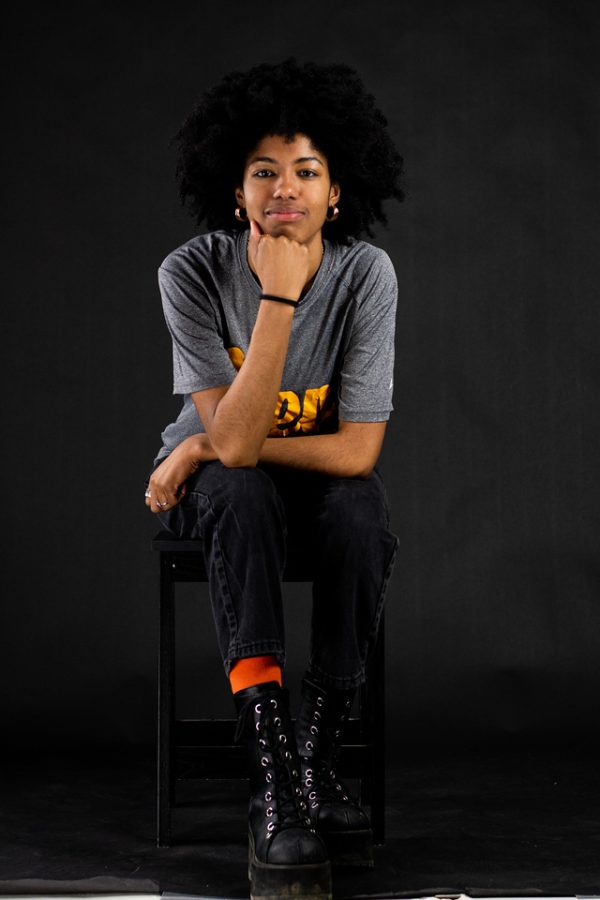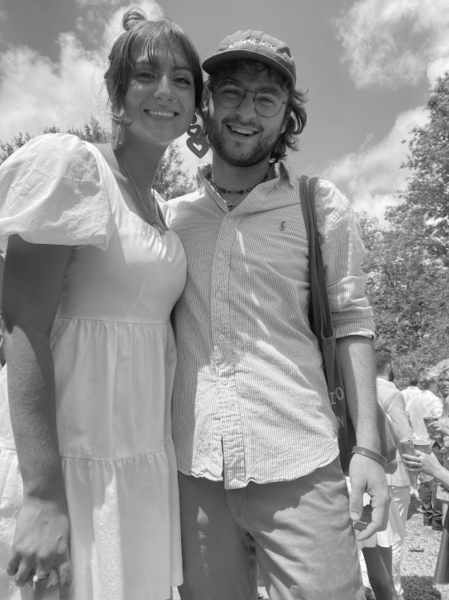Trans Day of Visibility Photoshoot Empowers Athletes
On March 31, the Oberlin Athletics Instagram account posted eight photos of Oberlin transgender student-athletes in celebration of Transgender Day of Visibility. Student-athletes posed in creative ways in front of a black background, which made the colorful expressions and unique poses stand out. Maggie Balderstone, a third-year athlete on the women’s basketball team, and Chase Sortor, a fourth-year athlete on the men’s track and field team, were the brains behind the TDOV photoshoot.
“Chase had talked to [Assistant Director of Athletics Communications] Amanda Phillips about wanting to do something like this, but there weren’t any solidified plans in place,” Balderstone said. “I reached out to him and said, ‘I heard you wanted to do this. I really wanna get involved and help out in any way I can. Let’s make it happen.’ He’s an ideas man and so I wanted to put his ideas into action.”
The TDOV shoot came to fruition with the goal of uplifting trans athletes. However, the shoot wouldn’t have been possible without the courage of the models — Balderstone and Sortor, as well as fourth-year Lucas Draper from the men’s swimming and diving team, third-year Dee Pegues from the field hockey team, fourth-year Post from the field hockey team, second-year Nora Holder from the men’s swimming and diving team, second-year Salem Holter from the field hockey team, and second-year Sage Reddish from the women’s track and field team.
In an email to the Review, Sortor commented on his experience as a model in the shoot and how he felt empowered by being in front of the camera.
“I had a great time as a model in the shoot,” Sortor wrote. “I love taking photos with Maggie and I think we created a safe, affirming space for people to feel confident. Photos of myself remind me of the hard work and obstacles I have overcome to exist in the body I do. Finding joy in the way that I look and my physical existence is something I will forever be grateful for.”
The shoot was not just a celebration of trans athletes at Oberlin, but a rebuttal against the rise of reactionary legislation across the country that aims to prohibit trans athlete participation in sports and abolish gender-affirming care for minors.
At the 134th General Assembly, the Ohio House of Representatives introduced House Bill 454, a bill that seeks to ban gender-affirming care for minors. The bill reads, “No physician or other medical health care professional shall provide gender transition procedures to any person under eighteen years of age. No physician, mental health provider, or other medical health care professional shall refer any person under eighteen years of age to any medical doctor for gender transition procedures.” The bill argues that studies show that gender-affirming surgical care has more drawbacks than benefits. However, this claim is empirically disproven.
“Research has shown that transgender individuals who choose gender-affirming surgery experience long-term mental health benefits,” the Cleveland Clinic’s website reads. “In one study, a person’s odds of needing mental health treatment declined by 8% each year after the gender- affirming procedure.”
Despite the perception of sports as gendered and hostile toward queer participants, Balderstone has found a safe space in Oberlin athletics.
“For me, being a trans athlete is a very liminal existence,” Balderstone said. “Being in women’s sports, but not identifying as a woman has been a very interesting experience for me. I think a lot of times it can be a very non-affirming space, but because of my teammates, because of my coaches, I’ve really carved out — and they’ve helped me carve out — a space [for] feeling affirmed in myself and being able to exist.”
Balderstone is looking to combat misinformation surrounding trans athletes by creating a workshop that educates Oberlin student-athletes about trans participation in sports.
“I think especially within our men’s teams, there’s a lot of misconceptions about what trans athletes are, who they are, and what we do,” Balderstone said. “I think some of them come from a place of, ‘I wanna save women’s sports.’ But I think at its core it’s just misunderstanding, and [athletes] not trying to educate themselves on the issue. So Oberlin as an institution, and this athletic department providing that education and workshopping so we can get all the information out there, is gonna be really beneficial moving forward.”
Phillips, who provided the venue and support for the TDOV photoshoot, has expressed her admiration for Balderstone’s and Sortor’s efforts to conceptualize and produce the final result.
“I will say, it was by far our most successful social campaign all year,” Phillips said. “One of the most successful in the past two-and-a-half years since I’ve been here. All credits go to Maggie and to Chase. They just did such a great job. Even in the studio, they had music going. They made it a very welcoming, warm space, and comfortable space. There’s nobody better who could have done this. They were absolutely the right people to take this on. I’m very impressed and proud of our athletes and how they came together and really made this happen.” Phillips and other staff members in the Athletics Communications Office are enthusiastic about uplifting voices and celebrating the diversity of the Oberlin student body. She has expressed a desire to make the TDOV shoot a yearly event while also starting traditions of photoshoots that celebrate Pride Month, Black History Month, and more.
“I think that, especially to other trans athletes, [it’s important to] keep doing the work, because it’s not an easy process at times, but it’s making a difference and proving to people that all types of people — all different bodies — can exist and thrive in sports,” Balderstone said. “What I love about sports is we can just keep pushing the envelope as to what sports looks like. Who is in sports, what they can do, is just ever-evolving. I think that’s so wonderful, and I think trans athletes are evolving sport more — we’re just evolving in a different direction. To the athletics community here, we have to continue to make space for trans athletes to feel 100 percent comfortable.”




